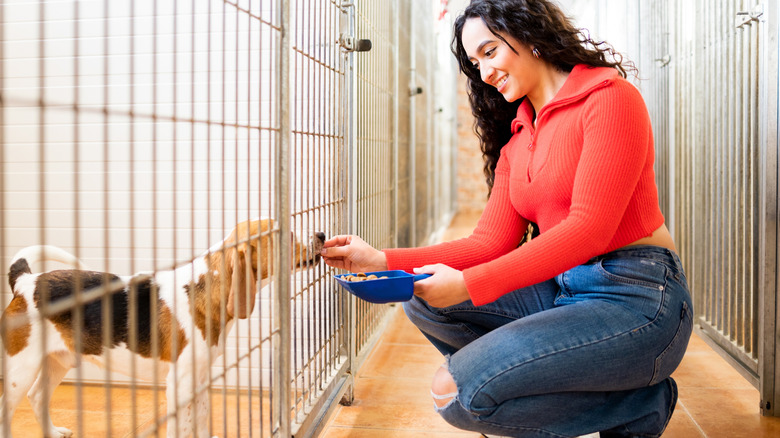Major Red Flags That An Adopted Dog From A Shelter May Have Behavioral Problems
When someone decides they're ready to adopt a dog, there are many questions to answer first, like what breed would suit their home and what supplies they need before bringing the dog into their life. In the step-by-step process of adopting a dog, one of the very first questions is whether to adopt from a shelter or a breeder.
Adopting from a shelter can be a rewarding experience, providing a home to a dog in need, especially one that may have had a tough life. However, the shelter environment doesn't always reflect a dog's true personality, as the atmosphere, interactions with other dogs, and strict schedule differ from those of domestic life; it presents a whole new set of challenges to face. Every dog is one-of-a-kind, and shelters usually put their best foot forward with a staff who love pets. Still, some signs, such as staff unwilling to answer questions, or anxiety symptoms, should alert owners that there might be hidden behavioral issues they won't notice until they bring their new friend home.
Staff is hesitant to answer questions and try to expedite the adoption process
Staff at shelters should understand and be respectful of the adoption process, recognizing how profoundly life-changing it can be. Questions like where the dog came from, whether they have been with other families before, and, most straightforwardly, whether or not they have behavioral issues, are essential. Asking whether a dog has bitten or been aggressive toward a person is also an important question that should come with a clear answer from staff.
There is a difference between not knowing and not disclosing. If shelter staff are hesitant to answer any questions, this can be a red flag that there are greater issues they are aware of. A potential owner needs to know as much as possible about a potential pet, particularly if they will be brought into a home with children or other pets.
The adoption process should never feel rushed or pressured. Many shelters will conduct an interview with the owner, hold a meeting at the shelter with the pet and staff, and also follow up after the adoption is complete. The more care the shelter puts into the process, the more time an owner has to understand the level of commitment they are taking on and notice any behavioral issues.
There is a lack of information on the dog and its history
There is a significant difference between adopting a senior dog from a shelter and a puppy, and factors such as breed can be potential indicators of common health or behavioral issues. A dog's past can also reveal a lot about how it will behave in specific environments.
No shelter is the same, as each offers either open, limited, or managed intake and is managed by different organizations. Depending on the approach of the shelter, they may not have all the information on a dog in their care; age, breed, and past can be misrepresented when they are not 100% certain and are not provided with a background on all animals coming into their care.
Whether it's not disclosing or simply not knowing, the clearer information a shelter can provide about adoption, the better. This way, an owner can assess potential challenges and determine if they can provide the proper resources and time. If you do bring home a pet with an unknown history, a vet visit or visit with an animal behaviorist, especially if you suspect any issues, can help.
The dog already shows signs of anxiety, aggression, or fear
A dog's behavior in a shelter can reveal some signs of how it will behave at home. While this may seem straightforward, meeting the dog you dreamed of can lead to overlooking what is right in front of you. In a shelter situation, anyone looking to adopt can observe existing behavioral issues, including dog and human aggression, phobias, resource guarding, and other compulsive behaviors.
Not all behaviors will be visible in a shelter due to the noise and presence of other animals, such as territorial aggression and separation anxiety. However, any issues observed in a shelter could lead to further problems at home; there is no guarantee that removing a pet from a shelter will resolve existing behaviors.
When it comes to newly adopted dogs with behavioral issues, there are several types of manageable anxiety, but this will depend on the owner's willingness to train and patience. Additionally, aggression can also pose a challenge for inexperienced owners who may struggle to address it on their own.
The shelter does not let you see the dog for an extended period of time
An important first step in meeting a potential pet is spending quality alone time with them; many shelters provide quiet zones for meet-and-greets. Creating an environment where you can spend one-on-one time with a dog will reveal a lot about its personality and whether it has any behavioral issues; many shelters even allow this time to meet existing pets as well. If a shelter does not offer these services for an adoption, it might be hiding potential problems the dog has or may not be as committed to finding the right match for it.
People never really know how or if they will find their 'soul pet,' and such a lifelong connection can come from anywhere. It is wise to keep your heart open when searching for a furry friend, but also be aware of any red flags indicating behavioral or physical health issues that may become a burden after adoption. For both humans and canines, the ideal adoption comes from that perfect pairing that leads to an unforgettable friendship.
Always consult your veterinarian before making changes to your pet's diet, exercise, or care. To find an accredited veterinarian in your area, you can search the American Animal Hospital Association's online database.




